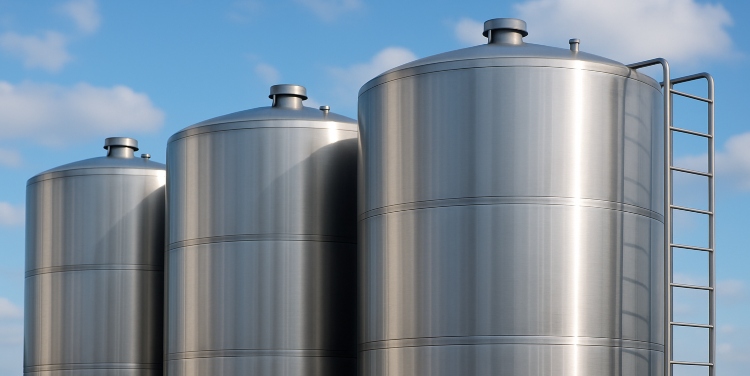For industrial enterprises handling chemical substances, safe storage is not merely a logistical challenge—it’s a critical responsibility. Steel tanks serve as essential infrastructure in sectors such as chemical manufacturing, pharmaceuticals, coatings, and waste treatment. Their primary function is to contain potentially hazardous liquids in a controlled, durable, and secure manner. An improperly designed tank could result in chemical leaks, structural failure, or even environmental damage—each posing serious financial, legal, and operational risks.
That is why careful planning during the design phase is essential. A well-engineered tank takes into account the specific characteristics of the stored medium, as well as operational and spatial constraints, creating a long-term solution that protects both personnel and the surrounding environment.
Understanding the properties of stored chemicals
One of the most important steps in designing steel tanks for chemical storage is conducting a thorough analysis of the material to be stored. Each chemical has a unique set of physical and chemical properties that influence the tank’s internal requirements. For example, acids may aggressively corrode untreated steel, solvents may permeate certain coatings, and alkaline substances might degrade gaskets and seals. It is not sufficient to base design decisions solely on the liquid’s name or industry use; instead, designers must consider factors such as pH, reactivity, vapour pressure, flash point, and concentration. These characteristics impact decisions related to wall thickness, the choice of corrosion-resistant coatings, ventilation needs, and material compatibility throughout the entire storage system. By tailoring the tank to the chemical’s exact behaviour, businesses significantly reduce the risk of contamination, corrosion, and equipment failure.
Selecting the appropriate corrosion protection system
In chemical storage, unprotected carbon steel is unsuitable for direct contact with most aggressive substances. While stainless steel may be effective in certain scenarios, its higher cost and selective chemical resistance make it impractical for many large-scale applications. A more common and economical solution involves using carbon steel tanks with internal and sometimes external coatings that are specifically engineered to resist corrosion. These coatings can include epoxy, phenolic, polyurethane, or rubber linings—each suited to different categories of chemicals. The protective layer acts as a chemical shield, preventing direct interaction between the steel surface and the stored medium. Proper surface preparation before coating is essential to ensure good adhesion and long-term durability. Additionally, coatings must be selected and applied in accordance with the chemical’s properties, operating temperature, and tank geometry. Regular inspections of these linings are necessary to detect any degradation before failure occurs.
Structural integrity and operational safety
Beyond material selection and coating systems, structural engineering plays a crucial role in tank safety and longevity. Tanks must be capable of withstanding both static loads, such as the weight of the stored liquid, and dynamic loads resulting from filling, emptying, or temperature-induced expansion. Large-capacity tanks may require reinforcement through stiffeners, supports, or foundation anchoring systems, especially in high-wind or seismic zones. Internal pressure variations, caused by vapour build-up or thermal shifts, also need to be managed through pressure relief valves or venting systems. Overfill protection and level monitoring systems should be standard features, as should secure access hatches and anti-corrosion external finishes. By incorporating these safety features into the tank’s design, companies can reduce downtime, protect employees, and comply with environmental protection expectations—all while ensuring the continued integrity of the storage unit.
Installation conditions and long-term maintenance
The location and installation of a steel tank have a significant impact on its long-term performance. For example, tanks installed above ground are more exposed to weather variations and may require additional insulation or UV protection, while underground tanks need enhanced external coating systems to resist moisture, soil pressure, and ground movement. Proper foundation design—whether concrete pads or steel saddles—is critical to prevent stress on the tank walls or base. Once installed, steel tanks must be maintained on a scheduled basis. Maintenance includes visual inspections, non-destructive testing of weld seams and coatings, functional checks of safety valves and sensors, and internal cleaning. These procedures help detect early signs of wear or damage, allowing companies to conduct preventative maintenance rather than emergency repairs. By integrating maintenance access points and serviceability features during the design phase, businesses ensure easier compliance and reduced operational disruption over the tank’s lifespan.
Value and reliability for industrial users
Professionally designed and maintained steel tanks provide companies with a robust, scalable, and highly customisable solution for chemical storage. These tanks can be fitted with heating coils, agitators, instrumentation ports, or automated filling systems to meet specific process needs. For users managing hazardous or high-value substances, the combination of coated carbon steel and engineered structural design ensures peace of mind and reliable performance even in demanding environments. Furthermore, well-designed tanks reduce product loss, protect against environmental incidents, and simplify regulatory audits. In an era where safety, traceability, and sustainability are becoming central concerns for industrial enterprises, steel tanks remain a cost-effective and adaptable asset that supports both productivity and compliance. With the right design strategy, they offer decades of dependable service across a wide range of chemical storage applications.
David Prior
David Prior is the editor of Today News, responsible for the overall editorial strategy. He is an NCTJ-qualified journalist with over 20 years’ experience, and is also editor of the award-winning hyperlocal news title Altrincham Today. His LinkedIn profile is here.













































































